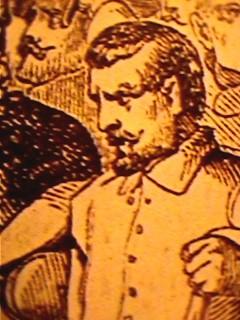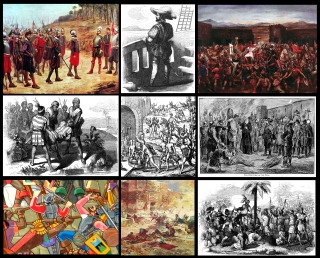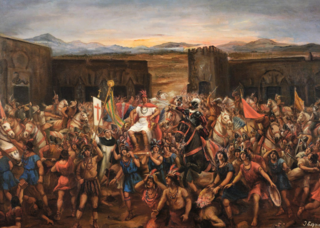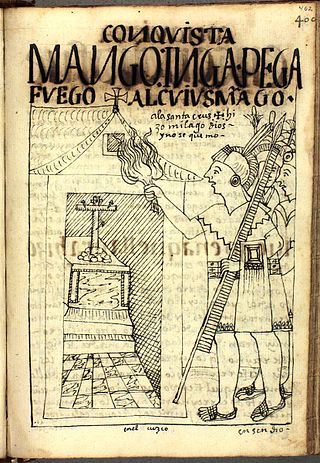
The Inca Empire, officially known as the Realm of the Four Parts, was the largest empire in pre-Columbian America. The administrative, political, and military center of the empire was in the city of Cusco. The Inca civilization rose from the Peruvian highlands sometime in the early 13th century. The Spanish began the conquest of the Inca Empire in 1532 and by 1572, the last Inca state was fully conquered.

The llama is a domesticated South American camelid, widely used as a meat and pack animal by Andean cultures since the pre-Columbian era.

In Inca mythology, Mama Ocllo, or more precisely Mama Uqllu, was deified as a mother and fertility goddess. In one legend she was a daughter of Inti and Mama Killa, and in another the daughter of Viracocha (Wiraqucha) and Mama Qucha. In all of them she was the older sister and wife of Manco Cápac, whom she established the city of Cusco with. In some variations, she also had a son with him, Sinchi Roca, though all Incan rulers after Manco Cápac were believed to be their descendants.

Gonzalo Pizarro y Alonso was a Spanish conquistador. He was the younger paternal half brother of Francisco Pizarro, who led the Spanish conquest of the Inca Empire. Pizarro was the illegitimate son of Gonzalo Pizarro y Rodríguez de Aguilar (1446–1522), who, as an infantry colonel, served under Gonzalo Fernández de Córdoba during the Italian Wars. He was also the younger paternal half brother of Hernándo Pizarro y de Vargas and the older paternal full brother of Juan Pizarro y Alonso.

The vicuña or vicuna is one of the two wild South American camelids, which live in the high alpine areas of the Andes; the other camelid is the guanaco, which lives at lower elevations. Vicuñas are relatives of the llama, and are now believed to be the wild ancestor of domesticated alpacas, which are raised for their coats. Vicuñas produce small amounts of extremely fine wool, which is very expensive because the animal can only be shorn every three years and has to be caught from the wild. When knitted together, the product of the vicuña's wool is very soft and warm. The Inca valued vicuñas highly for their wool, and it was against the law for anyone but royalty to wear vicuña garments; today, the vicuña is the national animal of Peru and appears on the Peruvian coat of arms.

Sinchi Roca, Sinchi Rocca, Cinchi Roca, Sinchi Ruq'a or Sinchi Ruq'a Inka was the second Sapa Inca of the Kingdom of Cusco and a member of the Hurin dynasty.

Vilcabamba or Willkapampa, often called the Lost City of the Incas, is a lost city in the Echarate District of La Convención Province in the Cuzco Region of Peru. Vilcabamba, in Quechua, means "sacred plain". The modern name for the Inca ruins of Vilcabamba is Espíritu Pampa.

The Spanish conquest of the Inca Empire, also known as the Conquest of Peru, was one of the most important campaigns in the Spanish colonization of the Americas. After years of preliminary exploration and military skirmishes, 168 Spanish soldiers under conquistador Francisco Pizarro, along with his brothers in arms and their indigenous allies, captured the last Sapa Inca, Atahualpa, at the Battle of Cajamarca in 1532. It was the first step in a long campaign that took decades of fighting but ended in Spanish victory in 1572 and colonization of the region as the Viceroyalty of Peru. The conquest of the Inca Empire, led to spin-off campaigns into present-day Chile and Colombia, as well as expeditions to the Amazon Basin and surrounding rainforest.

Manqu Inka Yupanki (Quechua) was the founder and monarch of the independent Neo-Inca State in Vilcabamba, although he was originally a puppet Inca Emperor installed by the Spaniards. He was also known as "Manco II" and "Manco Cápac II". He was one of the sons of Huayna Capac and a younger brother of Huascar.

Pachamanca is a traditional Peruvian dish baked with the aid of hot stones. The earthen oven is known as a huatia. It is generally made of lamb, mutton, alpaca, llama, guanaco, vicuna, pork, beef, chicken, or guinea pig, marinated in herbs and spices. Other Andean produce, such as potato or chuño, habas, sweet potato, mashua, oca, ulluco, cassava, yacon, plantain, humitas, ears of corn, and chilli, are often included in the baking.
Tupaq Wallpa ; before July 1533 – October 1533), original name Awki Wallpa Túpaq, was the first vassal Sapa Inca installed by the Spanish conquistadors, during the Spanish conquest of the Inca Empire led by Francisco Pizarro.

The Battle of Cajamarca, also spelled Cajamalca, was the ambush and seizure of the Incan ruler Atahualpa by a small Spanish force led by Francisco Pizarro, on November 16, 1532. The Spanish killed thousands of Atahualpa's counselors, commanders, and unarmed attendants in the great plaza of Cajamarca, and caused his armed host outside the town to flee. The capture of Atahualpa marked the opening stage of the conquest of the pre-Columbian civilization of Peru.

Vitcos was a residence of Inca nobles and a ceremonial center of the Neo-Inca State (1537–1572). The archaeological site of ancient Vitcos, called Rosaspata, is in the Vilcabamba District of La Convención Province, Cusco Region in Peru. The ruins are on a ridge overlooking the junction of two small rivers and the village of Pucyura. The Incas had occupied Vilcabamba, the region in which Vitcos is located, about 1450 CE, establishing major centers at Machu Picchu, Choquequirao, Vitcos, and Vilcabamba. Vitcos was often the residence of the rulers of the Neo-Inca state until the Spanish conquest of this last stronghold of the Incas in 1572.

The 10-month siege of Cusco by the Inca army under the command of Sapa Inca Manco Inca Yupanqui started on 6 May 1536 and ended in March 1537. The city was held by a garrison of Spanish conquistadors and Indian auxiliaries led by Hernando Pizarro. The Incas hoped to restore their empire (1438–1533) with this action, but it was ultimately unsuccessful.

The Comentarios Reales de los Incas is a book written by Inca Garcilaso de la Vega, the first published mestizo writer of colonial Andean South America. The Comentarios Reales de los Incas is considered by most to be the unquestioned masterpiece of Inca Garcilaso de la Vega, born of the first generation after the Spanish conquest.

The alpaca is a species of South American camelid mammal. Traditionally, alpacas were kept in herds that grazed on the level heights of the Andes of Southern Peru, Western Bolivia, Ecuador, and Northern Chile. More recently, alpacas may be found on farms and ranches worldwide, with thousands of animals born and raised annually. Alpacas are especially popular in North America, Europe, and Australia.

Lamini is a tribe of the subfamily Camelinae. It contains one extant genus with four species, all exclusively from South America: llamas, alpacas, vicuñas, and guanacos. The former two are domesticated species, while the latter two are only found in the wild. None display sexual dimorphism. The four species can interbreed and produce fertile offspring. Additionally, there are several extinct genera.
Mama Quilla, in Inca mythology and religion, was the third power and goddess of the moon. She was the older sister and wife of Inti, daughter of Viracocha and mother of Manco Cápac and Mama Uqllu (Mama Ocllo), mythical founders of the Inca empire and culture. She was the goddess of marriage and the menstrual cycle, and considered a defender of women. She was also important for the Inca calendar.
Gómez de Alvarado y Contreras was a Spanish conquistador and explorer. He was a member of the Alvarado family and the older brother of the famous conquistador Pedro de Alvarado.

Inca animal husbandry refers to how in the pre-Hispanic andes, camelids played a truly important role in the economy. In particular, the llama and alpaca—the only camelids domesticated by Andean people— which were raised in large-scale houses and used for different purposes within the production system of the Incas. Likewise, two other species of undomesticated camelids were used: the vicuña and the guanaco. The guanacos were hunted by means of chacos.
















